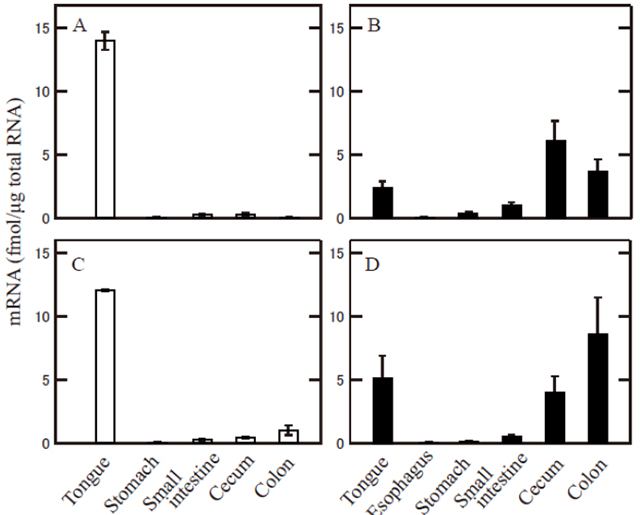July 10, 2013

From left, Assoc. Prof. Imai, Gifu Univ. Assoc. Prof. Matsumura, Researcher Gonda
Expression of taste signal transduction molecules were revealed not only in the tongue, but also in the cecum of common marmosets, by a research group organized with Associate Professor Hiroo IMAI of the Primate Research Institute (PRI), Kyoto University, Ms. Sae GONDA, a collaborative researcher of PRI in 2011-2013 (was a graduate student of Gifu University until March in 2013), Dr. Shuichi MATSUMURA and Dr. Shoichirou SAITO, Associate Professors of the Faculty of Applied Biological Sciences, Gifu University, as well as by Associate Professor Yasuhiro GO, the National Institutes of Natural Sciences (formerly worked as Assistant Professor of PRI).
This study was published in an online version of the British journal Biology Letters on July 10, 2013.

Common marmosets(Credit:Primate Research Institute)
The extraoral presence of taste signal transduction proteins has recently been reported in rodents and humans. Here, research group reports the presence of these signal transduction proteins in the cecum of a non-human primate, the common marmoset. Quantitative RT-PCR data on the gene expression of taste signal transduction molecules (gustducin and TRPM5) in common marmosets suggested high expression in the cecum, which was not observed in other non-human primates. Immunohistochemical analysis confirmed the specific presence of gustducin and taste receptors in marmoset cecal cells. These results may relate to the specific feeding behavior of marmosets, which consume plant exudates, primarily gums.

Fig1:Colocalization of taste-signaling molecules, gustducin (red) and TAS2Rs (green) in the marmoset cecum.

Fig2:Quantitative RT-PCR analysis of gustducin in the gastrointestinal tract of non-human primates. Plots show the expression level of gustducin mRNA in newborn (A, n=2) and adult (C, n=2) Japanese macaques and in newborn (B, n=4) and adult (D, n=3) common marmosets. Error bars indicate standard errors calculated from three independent experiments on each individual.
This work was supported by the Cooperation Research Program at the Primate Research Institute, Kyoto University and was financially supported by Grants-in-Aid for Scientific Research (21370109, 24370096, 24405018) from the Ministry of Education, Culture, Sports, Science, and Technology of Japan and additional grants from the Takeda Foundation for Science and the Suzuken Memorial Foundation to Assoc. Prof. Imai.
Paper information
[DOI] http://dx.doi.org/10.1098/rsbl.2013.0409
Biology Letters, 23 August 2013, vol. 9 no. 4
Title
Expression of taste signal transduction molecules in the cecum of common marmosets.

